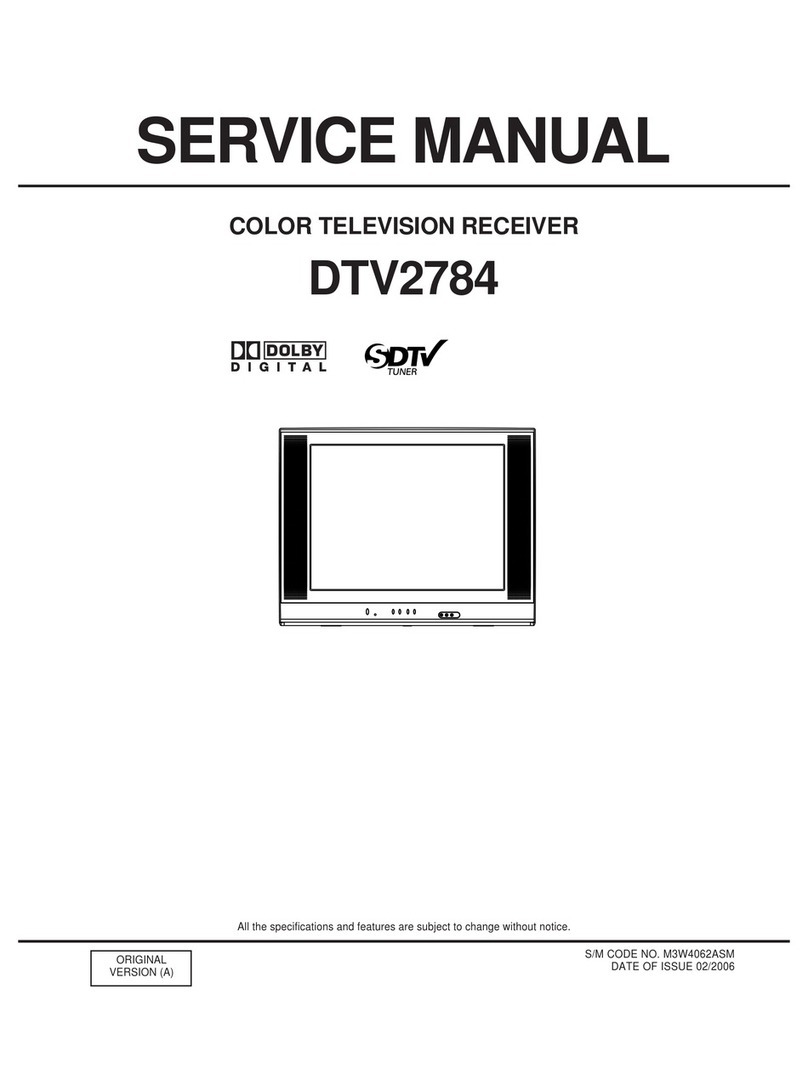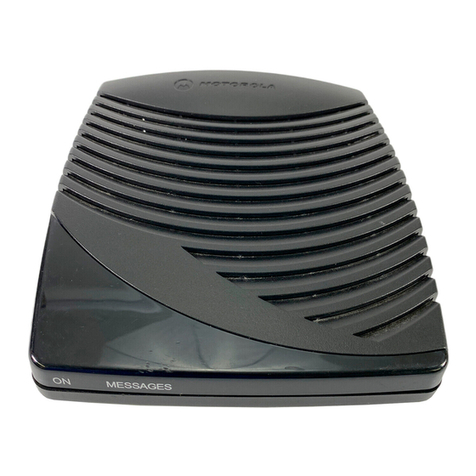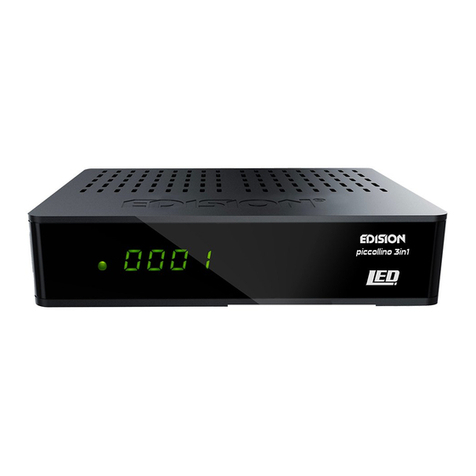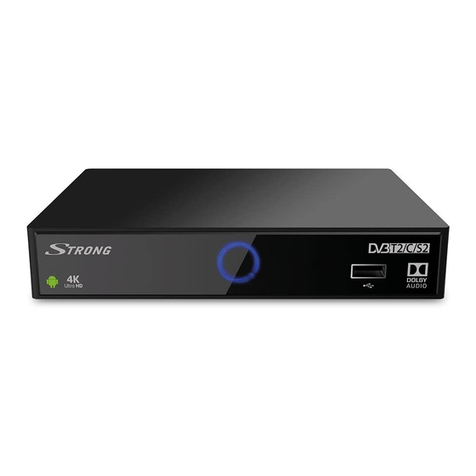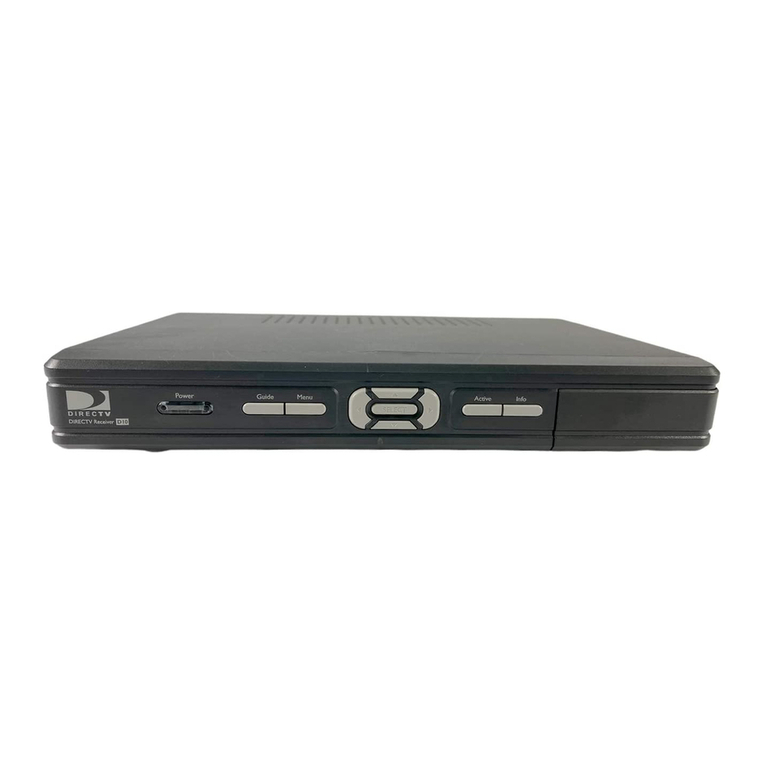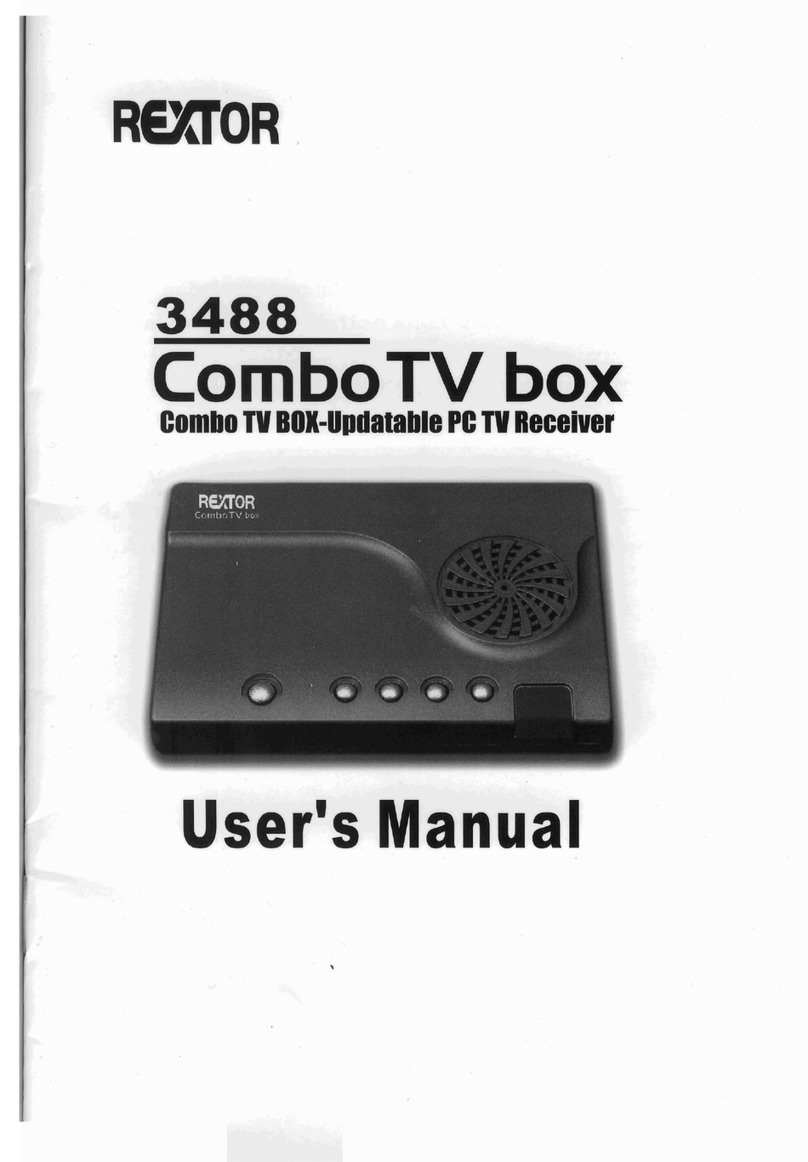Orion TC1973D User manual

COLOR TELEVISION RECEIVER
TC1973D
Irr!
0.
.
.
.
1
SPECIFICATIONS
1
UHF
CATV
All the specifications and features are subject to change without notice.

DISASSEMBLY INSTRUCTIONS
1. REMOVAL OF ANODE CAP
Read the following NOTED items before starling work.
After turning the power off there might still be a potential
voltage that is very dangerous. When removing the
Anode Cap, make sure to discharge the Anode Cap’s
potential voltage.
’Do not use pliers to loosen or tighten the Anode Cap
terminal, this may cause the spring to be damaged.
REMOVAL
1.
Follow the steps as follows to discharge the Anode Cap.
(Refer to Fig. l-l.)
Connect one end of an Alligator Clip to the metal part of a
flat-blade
screwdriver and the other end to ground.
While holding the plastic part of the insulated Screwdriver,
touch the support of the Anode with the tip of the
Screwdriver.
A cracking noise will be heard as the voltage is discharged.
GND
on
the CRT
GND on the CRT Fig. 1-l
2. Flip up the sides of the Rubber Cap in the direction
of
the
arrow and remove one side of the support
(Refer to Fig. l-2.)
Rubber Cap
CRT
V
Support
Fig.
1-2
3. After one side is removed. pull in the opposite direction to
remove the other.
NOTE
Take care not to damage the Rubber Cap.
INSTALLATlON
1. Clean the spot where the cap was located with a small
amount of alcohol. (Refer to Fig. l-3.)
NOTE
Confirm that there is no dirt. dust, etc. at the spot where
the cap was located.
2. Arrange the wire of the Anode Cap and make sure the
wire is not twisted.
3. Turn over the Rubber Cap. (Refer to Fig. l-4.)
Fig. 1-4
4

DISASSEMBLY INSTRUCTIONS
4,
Insert one end of the Anode Support into the anode button.
then the other as shown in Fig. I-5.
Fig.
l-
5. Confirm that the Support is securely connected.
6. Put on the Rubber Cap without moving any parts.
2. REMOVAL OF DEFLECTION YOKE
(Refer to
Fig. 2-1)
I.
Loosen the screw
0.
2. Remove the Convergence
.
Purity Magnet in the
direction of arrow (A).
3. Loosen the screw
0.
4. Remove the 3 Wedges.
5. Remove the Dellection Yoke in the direction of
arrow
(8).
INSTALLATION
tnstall new Deflection Yoke in reverse steps of REMOVAL.
NOTE
After adjusting the purity and the convergence. fix the
screw
0
and lock the wedges.
Wedge
Fig.
2-.
5

ELECTRICAL ADJUSTMENTS
1. BEFORE MAKING ELECTRICAL
ADJUSTMENTS
Read and perform these adjustments when repairing the
circuits or replacing electrical parts or
PC6
assemblies.
CAUTION
Use an isolation transformer when performing any
sarvce
on this chassis.
1.
CUTOFF
2.
VSIZE
3.
BRI.
AUTO
4.
X-RAY
5.
CONT
8.
END
Before removing the anode cap, discharge electricity
because it contains high voltage.
When removing a PCB or related component, after
unfastening or changing a wire, be sure to put the wire
back in its original position.
Inferior
sillcon
grease can damage
IC’s
and transistors.
When replacing
IC’s
and transistors. use only specified
silicon grease
(YG6260M).
Remove all old silicon before applying new silicon.
1-l: Prepare the following measurement tools far
electrical adjustments.
1.
Sweepmarker Generator
2. Oscilloscope
3. Digital Voltmeter
4. Color Bar Generator
L
Fig.
2-Z
1.
AUTO
2. vco
3. AFT
4. AGC
5. COL
6. TINT
7.
BRI
8. END
2. BASIC ADJUSTMENTS
Fig. 2-3
On-Screen Display Adjustment
the
of
a straightened paper clip into the hole
on remote control marked with an arrow as shown
2-1: VCO AND AFT
NOTE
Connect input and output terminals of the
sweepmarker generator to the circuit as shown
in Fig.
2-4-a,
it.
Fig. 2-f.
The adjustment mode display will appear as shown
Fig.2-2
andFig.2.3.
NOTE
Use the
1
8
keys on the remote control to select the
options shown in Fig. 2-2 and Fig. 2-3.
Press the 8 key to end the adjustments.
Fig. 2-l
SWEEPMAKER
GENERATOROUTPUT 0.22
rF
-
GND
SWEEPMAKER
GENERATOR INPUT 47Kohm
lN60
4.5
pF
Fig. 2-4-z
1.
Connect output terminal
of
Ihe
sweepmarker generator to
TP201.
2. Connect input terminal of the sweepmarker generator to
TP204.
3. Connect a
10K
ohm variable resistor to IF AGC terminal
(TP210).
12V
line and ground. lhen adjust to make the
wavelorm
01
the oscilloscope readable
3
,
f
.

ELECTRICAL ADJUSTMENTS
10
Kohm
AGC TP210
4. Activate the adjustment mode display (Fig.
2-3)
and
press the 2 key.
5. Adjust VOL. UP/DOWN key on the remote control until
the waveform maker
(45.75MHz)
becomes as shown in
Fig. 2-4-b.
6.
7.
6.
9.
45.75 MHz
x
Fig. 2-4-t
_
Disconnect output terminal
01
the sweepmarker generator
from
TP201,
then connect it to TP al the tuner pack.
Disconnect the
10K
ohm and the
2.7K
ohm variable
resistors.
Disconnect input and output terminals of the
sweepmarker generator.
Connect the AFT adjustment oscillator
(45.75MHz)
to TP of the tuner pack.
1 O.Connect the digital voltmeter to TP206.
1
l.Activate
the adjustment
mode
display (Fig. 2-3) and press
the 3 key.
12.Adjust
VOL. UP/DOWN key on the remote control to find
the point where the voltage of
TP206
changes dramatically,
and adjust to
4.5VDC
at that point.
2-2: BRIGHT, AGC, TINT AND COLOR
2-2-A: BRIGHT
1.
Receive the monochrome pattern.
2. Activate the adiustment mode displav
(Fig.
2-3)
and
press the 7
ke;.
,.
”
3. Press the VOL. UP/DOWN key on the remote control
until the boundary between 0% and 10% white starts
to become visible.
2-2-B: AGC
NOTE
Adjust after performing adjustments in section 2-1.
In case of weak electric field.
1. Tune to a noisy channel.
2. Activate the adjustment mode display and press
the 4 key.
3. Press the VOL. UP/DOWN key on the remote control
until noise is at minimum.
4.
Change the channel. confirm that the other channels
are normal.
In case of strong electric field.
(Radio frequency interference can
cause
diagonal
streaks to appear.)
1. Activate the adjustment mcde display and press
rhe
4
key.
2.
Press the VOL. UP/DOWN key
0”
the remote
control
untit
diagonal streaks are at minimum.
3. If there is still a problem after pressing the VOL. UP/DOWN
key on the remote control. install an attenuator to the
antenr,
terminals. then repeat step
1.
4. Confirm that noise does not appear.
5. Change the channel. confirm that the other channels are
normal.
2-2-C: TINT
1.
Receive the color bar pattern.
2. Connect the oscilloscope to TP023.
3. Activate the adjustment
mode
display (Fig. 2-3) and press
the 6 key.
4. Press the VOL. UP/DOWN key on the remote control
until
the waveform becomes as shown in Fig.
2-5.
1
I
Fig.
2i
2-2-D: COLOR
1.
Receive the color bar pattern.
2. Connect the oscilloscope to TP022
3. Activate the adjustment mode (Fig. 2-3) display and press
the 5 key.
4. Adjust the VOLTS RANGE VARIABLE knob of the
oscilloscope until the range between white 0% and
1
CO%
is set to 5 scales on the screen of the oscilloscope.
5. Press the VOL. UP/DOWN key an the remote control
untii
the red color level is adjusted to
4.75scalesf95%1
for
:he
white level. (Refer to Fig. 2-6)
I
b+4
I
I
95%
LL
h-
J
--OX
k
I-_-_-
--
100%
7
Table of contents
Other Orion TV Receiver manuals


